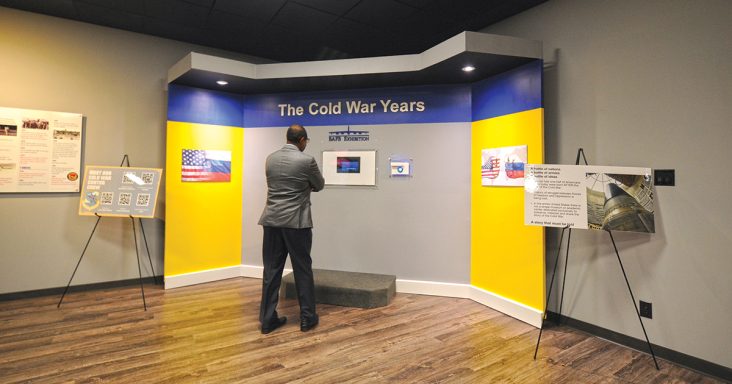Push continues for National Cold War Center, protection of airport
by February 6, 2023 7:33 pm 1,919 views

The Great Fire in Chicago helped to spur the development of one of the most important cities in Northeast Arkansas. The Reverend Henry T. Blythe settled in Mississippi County in 1853 near the town of Amorel. He farmed and preached for decades.
In 1871, the Great Fire destroyed much of the Windy City and when it came time to rebuild, lumber was needed. The area in and around Blytheville was logged and the timber was shipped north. Eventually, Blythe founded the city of Blytheville. For many years, it competed with another burgeoning town in the region, Jonesboro. The seat in Craighead County’s growth was fueled by the formation of Arkansas State University and St. Bernards Hospital. Blytheville’s growth was buoyed in the 1940s with the opening of Eaker Air Force Base, built to train pilots for World War II.
The base would be closed after the war ended, but was reopened in part because it had a massive runway that measures 11,600 feet. It’s the longest runway in Arkansas.
The federal government closed the base in 1992, which was a blow to the Blytheville community, according to the Encyclopedia of Arkansas. It reportedly employed 3,500 military personnel and 700 civilian support staff. When it closed the area lost about 6,500 people. It negatively impacted the regional economy. The city and county have spent decades trying to recover. Local civic and business leaders are trying to protect one asset, the Blytheville-Gosnell Regional Airport, while developing another potential asset — The National Cold War Center.
One problem is maintaining the runway.
It can cost millions of dollars to repair and resurface a runway. The National Guard conducts military training operations at the airport, and airport officials also have partnerships with private companies. It’s been negotiating a deal with the Federal Aviation Administration (FAA) to help pay for those costs.
“My biggest concern would be losing our appeal to businesses in the area or being forced to remove runway length,” said Billy Curl, a member on the airport and Cold War Center boards.
If the FAA doesn’t agree to provide funds, the airport would likely have to shorten the runway or find a way to cover expenses. The airport and FAA have reached a tentative agreement.
“Most recently, the FAA has said that we won’t need to shorten the runway but we are going to designate the number of 7,500 feet and they will fund that portion. This is an agreement that we can live with but we also haven’t seen anything in writing,” said Barrett Harrison, the airport president.
U.S. Rep. Rick Crawford, R-Jonesboro, recently visited the airport and told officials he supports their efforts to fund the airport and the center.
“The FAA has been occupied conducting an investigation into their recent system failure which may delay a resolution to this. If you feel like it’s not being resolved in a suitable time frame, please let me know and keep me updated,” Crawford said during his visit.
The center is a museum also located in a portion of the Blytheville-Gosnell airport that was once a facility used by the Eaker Air Force Base for Cold War operations. The museum has been trying to get federal designation as the National Cold War Center. Crawford introduced legislation in the last Congress which would get them the title if passed but the bill has not come up for a vote on the House floor.
“The designation would really give the work we do at the museum more credibility,” said Harrison.
The Blytheville Area Chamber of Commerce and the airport have teamed to build the center. It will center on the base’s still-intact “alert” compound, a facility that housed U.S. Air Force B-52 crews during wartime efforts of the 1950s through the 1990s. The museum could cost up to $20 million to build, and officials had hoped to have it open by 2023, but that timeline was before the COVID-19 pandemic. R. Byron Carlock Jr., a Blytheville native, is spearheading fund development.
A pinnacle moment during the Cold War has direct ties to the facility in Blytheville. In early October 1962, the Soviet Union began to build missile installations on the communist-controlled island country of Cuba. The Cuban Missile Crisis reached its zenith on Oct. 22, 1962. President John F. Kennedy delivered a national address and rebuked the Soviets for their actions. The U.S. military went to DEFCON II and the world was poised for war. Two B-52G bombers loaded with nuclear payloads were placed on airborne alert at Eaker Air Force Base. The bombers’ mission, should war erupt, would be to strike the Soviet Union with nuclear arms. The crisis was eventually averted and the bombers stood down.
In 2018, the air base was placed on the National Register of Historic Places. Since that time, a feasibility study has projected that a full museum would likely draw more than 50,000 visitors annually after three years.
Arkansas’ Department of Parks, Heritage and Tourism Division of Heritage distributed $1.9 million in restricted reserve funds toward the project in September. Nucor Steel Arkansas and Nucor-Yamato Steel Co. each donated $500,000 toward the center in November.
“As a Cold War veteran, I can say it was a pivotal time in American history where the threats were tremendous but we were all equally united in calling out our enemies. It’s vital that we keep alive the memory of those who were prepared to fight against the expansion of communism and lived under constant threat of nuclear obliteration,” Crawford said.
